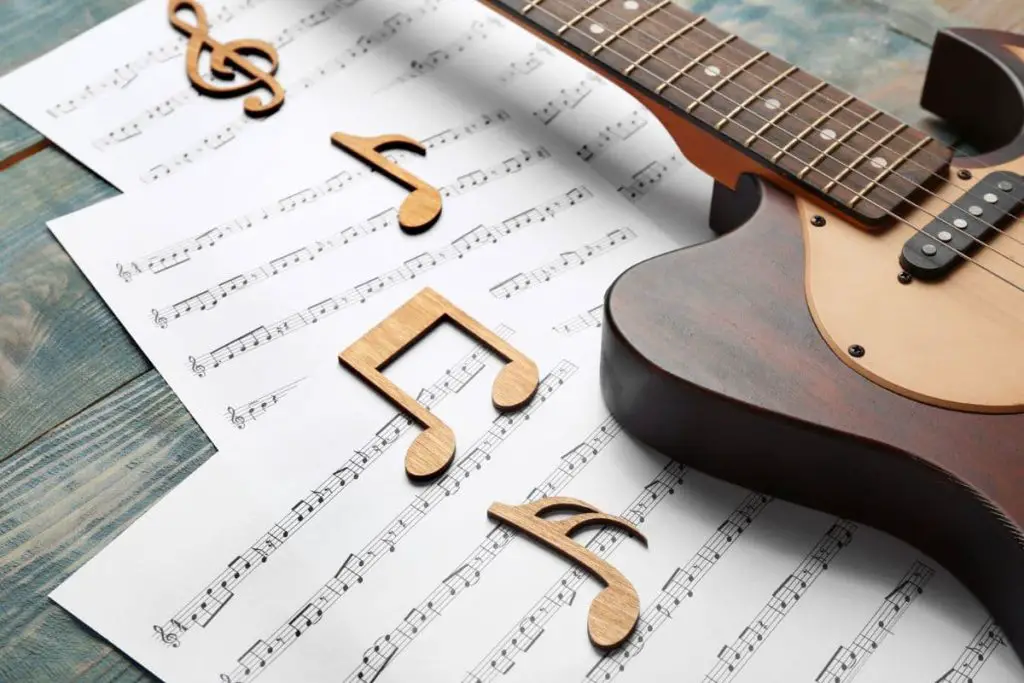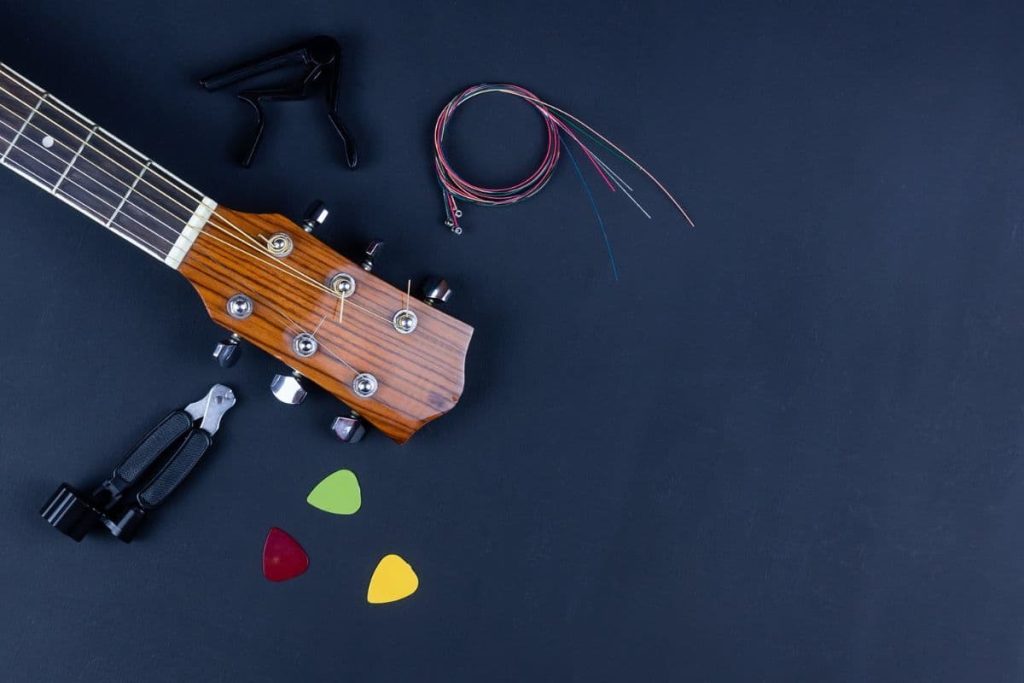The lines are sometimes blurry between beginner, intermediate and advanced levels of skill, with various definitions of each level depending on the activity it’s being assessed in. So, it may feel confusing to determine your skill level as a guitarist. What does being an intermediate guitar player look like?
Intermediate guitar players are in the middle stage between beginner and advanced. Some signs that you’re an intermediate guitar player include being able to quickly identify notes, play songs without tablature, jam comfortably with others, and even start creating their own tunes.
Reaching an intermediate level of guitar playing looks different for everyone, as evidenced by conversations with musicians Andrew Sowka from Winternom and Dave White from David Dino White. So, read on to learn what these musicians consider to be the 10 definite signs that you’re an intermediate guitar player.
If you want to find out what my recommended guitar gear is, then here is what I recommend on Amazon:
- Fender Cutaway Acoustic-Electric Guitar Bundle (MY FAVORITE GUITAR)
- Snark SN-8 Super Tight All Instrument Tuner (Easiest Tuner I’ve Used )
- 6 String Acoustic Guitar Capo (Best CAPO for quick changes)
- Dunlop Max Grip 1.0mm Nylon Picks (Thick Guitar Pick So You Don’t Lose Grip!)
- Universal Guitar Stand (Cheap & Minimalist Guitar Stand I Recommend)
- Levy’s 2″ Wide Quick Adjust Guitar Strap (Best Guitar Strap For Any Level)

1. You Can Feel and See Improvement
There’s no better feeling than being able to play an instrument well. That skill comes from dedicated practice and unadulterated passion. Intermediate guitar players have a stronger sense of confidence in their playing. They’re capable of feeling, seeing, and hearing their improvement.
Feeling comfortable playing a specific genre of music, says White, is a telltale sign of intermediate-level skill. A genre covers an array of unique playing styles. Finding strength in one genre also means having the confidence to play songs with different keys and tempos. You may also notice fewer mistakes in exercises you’ve practiced more often.
Turning the focus onto a new genre, technique, or playing style can be intimidating when your playing skills improve. Don’t be discouraged, though, because as an intermediate player, you now have a solid repertoire of skills to rely on throughout the learning process.
2. You Can Play Songs Without Sheet Music
Intermediate guitar players can play songs without having to follow along with sheet music or tabs. After practicing a set so often, playing often turns into muscle memory; you no longer need to read the notes because you know exactly how to play them already.
This is a critical skill for intermediate players that have (or want to have) on-stage experience. It isn’t typical for guitar players to read sheet music during a performance unless they’re playing at a recital. Memorizing notes and hand placements is a valuable skill and another definite sign of intermediate-level guitar playing.
Repetition is the best way to practice a song without sheet music. Break the piece down into sections and play it obsessively. This will transfer into muscle memory after some time. However, don’t solely rely on muscle memory to play your song! Intermediate guitar players can keep close track of what notes to play and when.
If you need sheet music to play, it doesn’t mean you aren’t an intermediate guitar player. In fact, it’s great to keep the notes handy in case you need them. You’re likely approaching an intermediate level when you can successfully play and follow sheet music with few to no mistakes.
3. You Can Easily Identify Notes and Keys
Hearing a key and identifying it is another sign of higher-level musical skills. While it isn’t a skill exclusive to guitar players, it shows a more significant knowledge base in music theory than most beginners have.
A few components of music theory that are essential for the aspiring musician include:
- Notes
- Keys
- Scales
- Harmonies
- Tempos
When these components start to flow more naturally after extensive studying (and practicing), it’s safe to say that you’ve leveled up as a guitarist.
Being able to easily reproduce notes you hear is another component of music theory indicative of competent playing skills. Intermediate guitar players are successfully developing their “ear for music,” which means they’re finessing their ability to hear, learn, and play music.

4. Your Influences and Idols Are Evolving
You may have looked up to a particular artist when you first started playing the guitar. Now, as an intermediate guitar player, you’ve noticed your influences and idols aren’t the same ones you had before. Suddenly, they’ve evolved into musicians that pique your interest or inspire you in new, more challenging ways.
As you move through intermediate and into a more advanced level, your musical horizon begins to broaden further. Different artists often act as excellent teachers, inspiring musicians with the motivation, passion, and drive they need to continue practicing.
White described being initially inspired by musicians like Jack White and Eric Clapton, for example, but eventually moved away from mainstream guitarists in favor of different genres and styles of playing, like the fanciful finger picking of Tommy Emmanuel.
5. You Can Jam and Improvise
Arguably one of the most fun parts of playing the guitar is jamming out with other musicians.
With a handful of instruments and a group of intermediate-level players, a lively jam session is an excellent way to improve your skill set. Playing in a group also creates opportunities to learn from and teach new techniques to others.
When seasoned musicians jam together, improvising comes easily. I once watched a Caley Campbell rehearsal session that involved mid-song edits, spontaneous new solos, and the impressive ability to play any of my song requests from memory.
An intermediate-level guitar player has a pretty extensive song repertoire, evidenced by watching the band rehearse, which makes jamming and improvising all the easier as skill improves!
6. You Need (or Want) Specific Gear
Naturally, as the playing level increases, a need or desire for specific musical equipment arises. Beginner guitar players might have a standard instrument that can last long if cared for properly. Regardless, learning more about the guitar also means learning more about what you can do with it.
For example, suppose an intermediate player wanted to learn how to finger-pick as Dave White did. In that case, they may start to look into different types of guitar strings. Or, should a musician want to play in front of an audience, an amp purchase might be in their future.
Either way, intermediate guitar players might find that they want to upgrade their gear. As the musician in them grows, their goals will transform and lead into directions that require specific amps, instruments, or accessories in order to be met.

Here are a few pieces of equipment (including accessories and guitar storage) that every guitarist should have, regardless of skill level:
Accessories
Certain accessories are needed to either help maintain the instrument or help to improve its quality of sound. Most, if not all, of this equipment, can be found at your local music store:
A Guitar Tuner
Guitar tuners are great for quickly and accurately keeping your instrument in tune. An out-of-tune guitar makes an unpleasant sound, so using a tuner whenever it happens – either a manual one, a pedal, or clip-on tuners- is necessary.
A popular, high quality and inexpensive tuner is the Snark Super Tight Clip-on Tuner (available on Amazon.com). This tuner is very easy to use and read, as it can be viewed from any angle and has a fast processing chip – making it both accurate and quick.
A Capo
A capo is a device that gets clipped onto the neck of the guitar, closing on some of the strings and thus creating a higher pitched sound. It can be a great tool when you want to play a song in a different key without changing the tune of the guitar.
A simple capo is the Donner Guitar Capo (available on Amazon.com). This capo is very durable and easy to use, so it won’t break or be challenging to move on your guitar strings.
An Amplifier
An amplifier is a piece of equipment that projects the instrument’s sound at a set volume. Excellent (and mandatory) for on-stage playing, an amp can also help clarify the instrument’s sound during practice or jam sessions.
Marshall amps are popular amongst musicians. A small, portable, and relatively inexpensive amp is the Marshall Amps Guitar Combo Amplifier (available on Amazon.com). This amp is conveniently sized and includes a headphone output, which is excellent for intermediate guitar players.
Guitar Storage
Storing your guitar correctly will ensure it’s well taken care of and thus can be played for a long time. Here are some guitar storage gear that are a necessity for intermediate guitar players:
A Guitar Case and Stand
A guitar case is essential for traveling with your instrument. While a guitar is sturdy enough, it isn’t indestructible and can easily suffer from scratches, dents, holes, and broken strings. A solid guitar case prevents unwanted damage to the guitar.
A solid cover guitar case is the best option for the ultimate protection, but modern guitar cases are waterproof with secure shoulder straps. The Cahaya Acoustic Guitar Bag (available on Amazon.com) is a stylish travel case designed like a backpack, making it very easy to carry and transport.
On the other hand, a guitar stand is suitable for the at-home storage of your instrument. Whether it stays in your jam space or your living room, a good guitar stand will keep your instrument out of the way of things that go on around your home.
The upright guitar stands are ideal as they provide lots of support to the instrument. The ChromaCast Upright Guitar Stand (available on Amazon.com) is a good, simple choice with rubber holders both at the neck and the base of the guitar.
A Pair of Headphones
Finally, a pair of headphones should definitely be added to the list of gear that an intermediate guitar player owns. During practices, especially with other musicians, the playing can be loud and damaging to the ears. For this reason, a good pair of headphones that muffle the volume of the music is critical to protecting your hearing.
Headphones can also be used to listen to back tracks while you’re playing; this is an excellent exercise to incorporate into your practice regime.
Audio-Technica Studio Headphones (available on Amazon.com) are fabulous headphones that muffle the music’s volume and have recording features, which can be used with music editing software.
7. You Have Concrete Musical Goals
Both White and Sowka stressed the need to create concrete musical goals. Regardless of skill level, all musicians develop goals for their playing, sometimes without even being aware of it.
A beginner guitar player wants to learn the basics of playing. They want to practice simple scales and train their musical ear to identify keys and scales, and they may want to learn to play for friends and family or just as a hobby. In this case, the beginner’s goals aren’t exceptionally demanding or rigid.
The goals of a session musician would look very different, though.
A session musician is a substitute for a player who can’t make a gig. As a result, this type of guitarist would need to have a wide range of experience with many genres of music. When music and career become intertwined, it’s even more important to have a set of goals to work towards.
Concrete goals are only beneficial if the musician consistently attempts to reach them. A beginner who doesn’t practice will never be able to maintain guitar playing as a hobby. Similarly, an intermediate player who doesn’t continuously put in whatever effort is needed to meet their goals simply won’t meet them!
Identifying and understanding one’s musical goals and regularly working towards them shows the dedication and commitment of an intermediate-level guitar player.

8. You Can Create Your Own Tunes
Similar to point 5 about improvisation, intermediate-level guitar players might start to challenge themselves by creating their own songs and melodies. It could look like physical improvising (with a guitar in hand) or involve exploring what keys sound good together by humming or whistling before translating it into sheet music.
Writing songs can be done alone or it can be an activity with others. Singer/songwriter circles are a great space to connect with other musicians. Jam sessions are great because the writing and playing can happen side-by-side, using trial-and-error on new ideas.
Several software programs allow musicians to add backing tracks (and more) to the new tunes they create. I’ll go over a couple of these programs in the following sections.
GarageBand
One such example is GarageBand, available on Apple computers and iPads. GarageBand has come a long way since its release in 2004, making it possible for today’s users to record their own music and put together entire songs.
GarageBand is an excellent free program for those with access to an Apple device. Guitarists can record their tunes, add backtracks, and adjust any effects (like the guitar’s volume, for example). With all these features, a complete song can be more easily put together, and the live recording adds an extraordinary touch.
The program also has free tutorials and classes for those who are just starting out in the music industry.
Audacity
Another program similar to GarageBand is Audacity. Although it has fewer features, this program is another free music recording software that allows musicians to bring their songs to life.
Audacity has editing and mixing features similar to GarageBand. However, Audacity can only record live vocals through a microphone, versus the ability to record all instruments in GarageBand.
Regardless, Audacity can be considered more widely accessible; it’s a program that works on Windows, Mac, and Linux operating systems.
9. If You Had To Teach What You Know, You Could
A simple sign of intermediate-level guitar playing is the ability to feel confident when teaching beginners. Most learned guitar players can successfully lead a beginner through the foundations of the instrument, including aspects such as music theory. They may also be able to easily teach scales and chord progressions and offer advice on how best to practice.
Essentially, being able to instruct a new or beginner guitarist with ease and accuracy is a sign of more advanced learning. It shows a deeper understanding of how to handle the instrument, how to play it well, and how to conceptualize the knowledge in a way others can grasp.
Teaching and learning also go hand-in-hand, as frequently, the teacher will learn something new while teaching the student! If you came across something that stumped you during a lesson, finding the answer can help you and the individual you’re instructing!
10. You Realize How Little You Know
Finally, the most definitive sign that you’re an intermediate guitar player is this: you’re beginning to realize just how little you actually know.
The world of guitar is just beginning to open up to you as an intermediate-level player. Hopefully, you’re starting to realize the spectrum of opportunities that are available with higher levels of guitar playing, that half the fun in playing the instrument is constantly getting to know it.

There are many ways to make unique music with a guitar; as an intermediate guitar player, you learn how to play your unique tune. This is all while simultaneously realizing that there is so much more that you can do the more you practice.
Despite having more work to do to become an advanced musician, the intermediate guitar player shows dedication, excitement, and consistency in their playing with an eager willingness to forge forward. They take each learning opportunity in stride, without biting off more than they can chew but accepting challenges to improve.
What is considered an intermediate guitar player?
An intermediate guitar player is someone who has a solid understanding of the basics of playing guitar and is able to play more complex chords, melodies, and techniques. Typically, an intermediate guitarist has been playing for several months to a few years and has a good understanding of music theory, rhythm, and technique.
Some intermediate guitar player skills include:
- The ability to play barre chords and more complex chord progressions
- A basic understanding of music theory, such as scales, modes, and chord progressions
- The ability to play more complex strumming patterns and fingerpicking techniques
- A good sense of rhythm and timing
- The ability to play basic lead guitar lines and solos
However, it’s important to note that there is no strict definition of what makes an intermediate guitarist, and the level of proficiency can vary widely depending on the individual’s practice habits and experience. Ultimately, the best way to improve as a guitarist is to continue practicing and learning new techniques and styles.
How good is an intermediate guitar player?
In terms of technical ability, an intermediate guitar player is able to play more complex chords, such as barre chords, and is comfortable with basic lead guitar lines and solos. They have a good sense of rhythm and timing, and are able to play more complex strumming patterns and fingerpicking techniques. They also have a basic understanding of music theory, including scales, modes, and chord progressions.
However, it’s important to note that technical ability is just one aspect of guitar playing, and there are many other factors that contribute to a player’s overall musicianship. For example, an intermediate guitar player may not have much experience playing in a band or performing live, or may not have much experience with different styles of music.
Ultimately, the level of proficiency of an intermediate guitar player is relative and depends on the individual’s goals and aspirations. An intermediate player may be more than good enough for some situations, while for others they may need to continue developing their skills and techniques to progress further.
How long does it take to be an intermediate guitar player?
Generally speaking, it may take anywhere from several months to a few years of consistent practice to become an intermediate guitar player. During this time, a player may learn and practice basic guitar chords and strumming patterns, as well as more advanced techniques such as fingerpicking, arpeggios, and barre chords.
Other factors that can impact the time it takes to become an intermediate guitar player include the frequency of practice sessions, the quality of instruction or self-guided learning, and exposure to different genres and playing styles.
It’s important to remember that becoming an intermediate guitar player is not a fixed point in time, but rather a subjective measure of one’s progress as a musician. Some players may progress more quickly or slowly than others, and it’s important to focus on steady improvement rather than comparing oneself to others.
Ultimately, the key to progressing as a guitar player is consistent practice and a willingness to learn and explore new techniques and styles. With dedication and perseverance, anyone can become an intermediate guitar player and beyond.
What are the levels of a guitar player?
Here are some common terms used to describe the different levels of a guitar player (guitarist):
- Beginner: A beginner guitarist is someone who is just starting out with the instrument and has little or no experience playing. They may be learning basic open chords and strumming patterns, as well as fundamental techniques like picking and fretting.
- Intermediate: An intermediate guitar player (guitarist) is someone who has a solid understanding of the basics of playing guitar and is able to play more complex chords, melodies, and techniques. They are comfortable with basic lead guitar lines and solos and have a good sense of rhythm and timing.
- Advanced: An advanced guitarist is someone who has a high level of technical proficiency on the instrument and is able to play complex chord progressions, intricate lead lines, and challenging techniques like sweep picking or tapping. They have a deep understanding of music theory and can improvise and compose their own music.
- Professional: A professional guitarist is someone who earns a living from playing guitar, either through performing, teaching, or recording. They have a high level of technical proficiency and a deep understanding of the business side of the music industry.
It’s important to remember that these terms are subjective and the level of proficiency can vary widely depending on the individual’s practice habits and experience. Ultimately, the best way to progress as a guitarist is to continue practicing and learning new techniques and styles, regardless of what level you consider yourself to be at.
What is the difference between intermediate and advanced guitarist?
Intermediate guitarists have an understanding of the basics of playing guitar and are able to play more complex chords, melodies, and techniques. Advanced guitarists are able to play complex chord progressions, intricate lead lines, and challenging techniques like sweep picking or tapping.
Intermediate guitarists are comfortable with basic lead guitar lines and solos and have a good sense of rhythm and timing. They have a basic understanding of music theory, including scales, modes, and chord progressions.
Advanced guitarists have a deep understanding of music theory and can improvise and compose their own music. They also have a great deal of experience playing with other musicians, and are able to adapt to a variety of musical situations.
In addition to technical proficiency, advanced guitarists also have a strong sense of musicality and creativity. They are able to express themselves through their playing and are not limited by their technical ability. They have a deep understanding of the language of music, including dynamics, phrasing, and tone, and are able to use these elements to create music that is expressive and meaningful.
Ultimately, the difference between an intermediate and advanced guitarist is a matter of degree. While intermediate guitarists may have a solid foundation in the basics of playing guitar, advanced guitarists have taken that foundation and built upon it to create a more sophisticated and nuanced musical vocabulary.
How much should an intermediate guitar player spend on a guitar?
A mid-range guitar in the $500 to $1000 range can be a good investment for an intermediate player who is serious about improving their skills and playing in more challenging musical settings.
It’s also important to consider the type of music the intermediate guitarist is interested in playing, as certain styles of music may require a specific type of guitar. For example, a player interested in playing heavy metal may want to look for a guitar with high-output pickups and a locking tremolo system, while a player interested in playing jazz may want to look for a guitar with a hollow or semi-hollow body and a warm, mellow tone.
Ultimately, the amount an intermediate guitar player should spend on a guitar is a personal decision that depends on their individual needs and goals. It’s important to do research and try out different guitars to find one that feels and sounds good and fits within your budget.
What should an intermediate guitar player be able to do? (Skills)
An intermediate guitar player should have a good foundation in the basics of guitar playing and be able to perform the following:
- Play chords: An intermediate guitar player should be able to play a wide range of chords, including barre chords and seventh chords, and be able to switch between them smoothly.
- Play scales: An intermediate guitar player should be able to play major and minor scales and their modes across the fretboard and be able to use them to improvise solos.
- Fingerpicking: An intermediate guitar player should be able to use fingerpicking techniques to play melodies and accompaniments.
- Strumming: An intermediate guitar player should be able to strum different rhythms and patterns using a variety of strumming techniques.
- Play songs: An intermediate guitar player should be able to play a variety of songs by reading chord charts or sheet music and be able to create their own arrangements.
- Understand music theory: An intermediate guitar player should have a basic understanding of music theory, including chord progressions, scales, and modes, and be able to apply this knowledge to their playing.
- Improvisation: An intermediate guitar player should be able to improvise over chord progressions using scales and arpeggios.
- Techniques: An intermediate guitar player should be able to use a range of techniques such as vibrato, bending, hammer-ons, pull-offs, and slides to add expression and nuance to their playing.
Overall, an intermediate guitar player should have developed a good sense of rhythm, timing, and musicality, and be able to apply these skills to a variety of musical contexts.
What makes you an intermediate guitar player? (Criteria)
Here are some general guidelines that can help determine if you are an intermediate guitar player:
- Proficiency in playing chords: As an intermediate guitar player, you should be able to play a wide range of chords, including barre chords and seventh chords, and be able to switch between them smoothly.
- Familiarity with scales and modes: An intermediate guitar player should be able to play major and minor scales and their modes across the fretboard and be able to use them to improvise solos.
- Ability to fingerpick: As an intermediate guitar player, you should be able to use fingerpicking techniques to play melodies and accompaniments.
- Good understanding of music theory: An intermediate guitar player should have a basic understanding of music theory, including chord progressions, scales, and modes, and be able to apply this knowledge to their playing.
- Versatility in playing different styles: As an intermediate guitar player, you should be able to play a variety of musical styles, such as rock, blues, folk, jazz, and classical.
- Ability to improvise: An intermediate guitar player should be able to improvise over chord progressions using scales and arpeggios.
- Mastery of basic techniques: An intermediate guitar player should have a good command of basic techniques such as vibrato, bending, hammer-ons, pull-offs, and slides, and be able to use them effectively in their playing.
Intermediate Guitar Songs
Here are some songs that intermediate guitar players can try learning:
- “Wonderwall” by Oasis – This song uses basic open chords and strumming patterns, making it a great song for intermediate players to practice.
- “Tears in Heaven” by Eric Clapton – This song features fingerpicking patterns and arpeggios, making it a good choice for intermediate guitarists looking to improve their fingerstyle playing.
- “Stairway to Heaven” by Led Zeppelin – This classic rock song features a mix of fingerpicking, chord progressions, and solos, making it a great challenge for intermediate players.
- “The A Team” by Ed Sheeran – This song uses basic fingerpicking patterns and open chords, making it an accessible song for intermediate guitar players to learn.
- “Blackbird” by The Beatles – This song features intricate fingerpicking patterns and arpeggios, making it a great song for intermediate guitarists to practice their fingerstyle playing.
- “Wish You Were Here” by Pink Floyd – This song uses a mix of strumming patterns, chord progressions, and solos, making it a good challenge for intermediate players.
- “Landslide” by Fleetwood Mac – This song features fingerpicking patterns and arpeggios, making it a good choice for intermediate guitarists looking to improve their fingerstyle playing.
- “Fast Car” by Tracy Chapman – This song uses basic open chords and strumming patterns, making it a great song for intermediate players to practice.
These are just a few examples of songs that intermediate guitar players can try learning. There are many other songs in different genres and styles that would also be suitable for intermediate players.
Intermediate Guitar Lessons
Here are some topics that intermediate guitar lessons can cover:
- Chord progressions: Intermediate guitar players can learn how to create and play more complex chord progressions, including seventh chords, extended chords, and jazz chords.
- Scales and modes: Intermediate guitar players can learn how to play major and minor scales in different positions on the fretboard and explore modes such as Dorian, Phrygian, and Mixolydian.
- Fingerstyle techniques: Intermediate guitar players can learn advanced fingerpicking patterns, including Travis picking, arpeggios, and hybrid picking.
- Soloing and improvisation: Intermediate guitar players can learn how to improvise over chord progressions using scales, arpeggios, and different techniques such as bending, vibrato, and slides.
- Music theory: Intermediate guitar players can deepen their understanding of music theory, including chord construction, key signatures, and harmonic analysis.
- Ear training: Intermediate guitar players can work on their ability to recognize and play melodies and chord progressions by ear.
- Rhythm and timing: Intermediate guitar players can practice different rhythms and time signatures, including odd meters such as 5/4 and 7/8.
- Songwriting and arranging: Intermediate guitar players can learn how to write and arrange their own songs, including melody writing, chord progressions, and song structure.
Here are some YouTube channels that offer free Intermediate Guitar lessons:
- Chord progressions:
- Justin Guitar: https://www.youtube.com/user/JustinSandercoe
- Marty Music: https://www.youtube.com/channel/UCmnlTWVJysjWPFiZhQ5uudg
- GuitarLessons365: https://www.youtube.com/user/GuitarLessons365Song
- Scales and modes:
- GuitarLessons365: https://www.youtube.com/user/GuitarLessons365Song
- Paul Davids: https://www.youtube.com/user/LuhaGuitar
- Signals Music Studio: https://www.youtube.com/user/signalsmusicstudio
- Fingerstyle techniques:
- Gareth Evans: https://www.youtube.com/user/GarethEvansUK
- LickNRiff: https://www.youtube.com/user/LickNRiff
- Justin Johnson: https://www.youtube.com/user/justinjohnsonlive
- Soloing and improvisation:
- Steve Stine: https://www.youtube.com/user/stinemusiclessons
- Tomo Fujita: https://www.youtube.com/user/TomoFujitaMusic
- Jens Larsen: https://www.youtube.com/user/jenslarsen02
- Music theory:
- Rick Beato: https://www.youtube.com/user/pegzch
- Adam Neely: https://www.youtube.com/user/havic5
- 12tone: https://www.youtube.com/user/12tonevideos
- Ear training:
- Perfect Ear: https://www.youtube.com/channel/UC-8Am9bj1cGJb0zXCZJHeGg
- Rick Beato: https://www.youtube.com/user/pegzch
- Signals Music Studio: https://www.youtube.com/user/signalsmusicstudio
- Rhythm and timing:
- Lessons with Troy: https://www.youtube.com/user/TroyBrenningmuhl
- Scott’s Bass Lessons: https://www.youtube.com/user/devinebass
- Drumeo: https://www.youtube.com/user/freedrumlessons
- Songwriting and arranging:
- Rick Beato: https://www.youtube.com/user/pegzch
- Holistic Songwriting: https://www.youtube.com/user/berkleeonline
- Songwriting 101: https://www.youtube.com/channel/UCwNViAcB6UgvvNi-lbsm4Mw
These channels offer a wealth of knowledge on each topic, and I hope you find them helpful in your learning journey.
Intermediate Guitar Practice Routine
Here is a possible intermediate guitar practice routine that you can follow:
- Warm-up exercises: Spend 5-10 minutes warming up your fingers and hands by playing simple exercises such as chromatic scales, finger stretching, or hand stretches.
- Scales and modes: Spend 10-15 minutes practicing scales and modes in different positions on the fretboard. Start with major and minor scales, and gradually move on to modes such as Dorian, Phrygian, and Mixolydian.
- Chord progressions: Spend 10-15 minutes practicing chord progressions, focusing on seventh chords, extended chords, and jazz chords. Practice switching between chords smoothly and in time with a metronome.
- Fingerstyle techniques: Spend 10-15 minutes practicing advanced fingerpicking patterns, such as Travis picking, arpeggios, and hybrid picking. Focus on accuracy and speed.
- Soloing and improvisation: Spend 10-15 minutes practicing soloing and improvisation over chord progressions. Use scales, arpeggios, and different techniques such as bending, vibrato, and slides to create melodic and expressive solos.
- Song learning: Spend 10-15 minutes learning and practicing a song or a section of a song that challenges your skills. Choose a song that you enjoy and that incorporates the techniques you have been practicing.
- Cool down: Spend 5-10 minutes playing slow and calming chords or fingerpicking patterns to relax your fingers and hands.
Remember to take breaks as needed and not to overdo it. This routine can be adjusted to fit your own goals, skill level, and time constraints. Aim to practice regularly, at least 30 minutes a day, to see progress in your playing.
10 Best Intermediate Guitars: What Kind of Guitar for the Intermediate Guitar Player?
Here are the 10 best intermediate guitars for an intermediate guitar player:
- Fender Player Series Stratocaster
- Gibson SG Standard
- Epiphone Les Paul Standard
- Ibanez RG Series
- Yamaha Pacifica Series
- Taylor 114ce
- Martin DX1E
- Gretsch G5420T Electromatic
- Seagull S6
- Epiphone Dot
If you want to find out what my recommended guitar gear is, then here is what I recommend on Amazon:
- Fender Cutaway Acoustic-Electric Guitar Bundle (MY FAVORITE GUITAR)
- Snark SN-8 Super Tight All Instrument Tuner (Easiest Tuner I’ve Used )
- 6 String Acoustic Guitar Capo (Best CAPO for quick changes)
- Dunlop Max Grip 1.0mm Nylon Picks (Thick Guitar Pick So You Don’t Lose Grip!)
- Universal Guitar Stand (Cheap & Minimalist Guitar Stand I Recommend)
- Levy’s 2″ Wide Quick Adjust Guitar Strap (Best Guitar Strap For Any Level)
Related Posts:
- How To Ship A Guitar Safely (With and Without a Case)
- 5 Reasons Why Acoustic Guitars Are So Expensive
- 20 Reasons Why Your Guitar Playing Sounds Bad
- This Is How Guitarists Make Their Solos
- How To Play Bar Chords On Acoustic Guitar (Easy Beginner Tutorial)
- Best Acoustic Guitars
- 9 Reasons Why Guitar Players Make Such Weird Faces
- Best Gifts For Guitar Players (Unusual, Expensive, Personalized, or Vintage)

